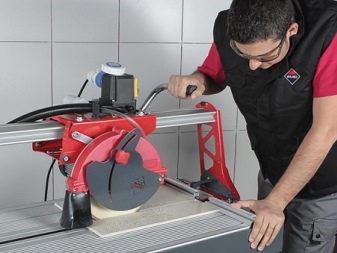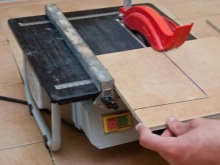All about porcelain tile cutters

The tile cutter helps out in situations in which sawing the tile would lead to significant complications: the appearance of chips on the front side of the tile fragments, the raising of a large amount of dust with its repeated settling on the glossy surface of the tile. This tool, like all others like it, is designed for convenience.


What it is?
Tile cutters for porcelain stoneware can do much more than a conventional grinder with a stone disc. Ceramics and granite are building materials that can withstand high mechanical stress, in contrast to tiles, having a hardness, above which only especially strong grades of steel, pobeditovy alloy and diamond dusting are used. Matte porcelain stoneware tiles are able to withstand the load that wood cannot cope with. Accordingly, the requirements for the tile cutter disc are increased: for cutting ceramics, granite and concrete, only diamond-coated discs and cutters are suitable. To prolong the life of the blade or hand cutter, the tile is wetted with water before and during cutting.



The manual tile cutter can be equipped with special cutting attachments that allow you to make curved cutting, mechanical - completed with crowns that make round holes, for example, for heating, water supply and sewerage pipes. Conventional tile cutters have a drawback - they do not cut properly when the edge from the edge of the tile fragment lies closer than 4 mm: it will not cut, but break off, here it is better to use a grinder with a diamond disc, tile tongs or a tool in which cutting is performed in water.


Views
According to the type of source of applied force, tile cutters are divided into manual and electric. Many of the models presented below support working with standard tiles - 600x600 mm per piece. Tiles 1200x600 mm can be easily cut in two.


Manual
Simple tile cutters - manual - are equipped with only a fixed or replaceable cutter, which resembles a glass cutter blade. Using the sliding method, as, for example, when cutting soft materials with an ordinary knife, the tiles cannot be cut in large volumes, therefore all manual tile cutters are made in the form of a roller with a hinge (sometimes on a ball bearing cage), fixed to the frame (base). In essence, it is the same diamond for cutting glass, but designed for a significantly greater thickness, up to 10 times that of glass. However, this tool has an adjustable guide, which, sliding along the edge of the tile fragment, does not allow the cutter to leave the cut line.
There is a large selection of manual tile cutters for tiles and tiles up to 600 mm wide. The length of the tile fragment can be up to 1200 mm. The thicker the tile, the more massive the cutter, and the thicker the diamond coating on its tip (edge). The most typical type of mechanism is roller.
Such tile cutters do not contain bearings for which a high load is critical (increased force when cutting tiles).


Electrical
Electric (mechanical, electromechanical) tile cutters - in fact, an improved grinder, with a fixed or adjustable protective cover (for different diameters of discs, up to 30 cm), adjustable rails, suspension-shock absorber based on a spring and an improved handle that can be rotated for convenient work in different, including confined, conditions.Their power is sufficient - up to 2 kilowatts, to cope with cutting tiles up to 3.5 cm thick.
Geared tile cutters are not direct drive - they have a reduction gearbox in order to reduce the load on the motor bearing assembly. Bearings do not have such a gearbox, but they do not withstand too high a force (pressure) when cutting.



Model rating
The best tile cutter is, by definition, the most powerful and fastest, but also the most affordable (cheapest). Manual tile cutters do not provide effective performance during massive construction and repair work, as well as with a single, but significant amount of work.
- Germans Boada Is the company that manufactures RUBI tile cutters. The TM-70 model cuts ceramic and porcelain stoneware up to 21 mm. The chrome-plated stainless steel guides and the lateral cut stop allow you to walk the cut line twice in the event of undercuts in one step, as well as to make a second cut at an angle of 45 and 90 degrees. Suitable for large tiles. The tile cutter is optimal in terms of cost and quality of the product.

- Matrix 600 mm - a device that cuts tiles mainly 600 and 500 mm in width and length. One I-beam guide, bearing mechanism for cutting. The cutter carriage is surrounded by a guide on both sides. Clamping mechanism of the grip. Ball guided ball grip that prevents the tool from sliding when cutting the slab. Lightweight arm stroke. Aluminum frame - the tool is easy to carry.

- Sigma 3C3M - 1150 kg weight force on cutting. The width of the tiles is 72 cm. Designed for tiles with complex relief and texture. The ball-bearing handle makes it possible to cut tiles smoothly, even in hard-to-reach places. Cushioning improves ride comfort. Built-in centering ruler for cutting tiles at significant angles.

- MONTOLIT 26PB - professional model. Rigid base designed for extremely smooth cuts. Tile thickness - up to 25 mm. The depth-of-cut adjustment makes it possible to evenly split tiles up to 25 mm thick.

- Stayer 3310-60 - the model, equipped with a circular cutter, is designed for 1.5-centimeter tiles, produces circular and straight cuts, holes of an ideal shape with a diameter of 3-8 cm. External ruler and right angle, 45-degree square.

- BASIC PLUS 60 comes with a suitcase. Aluminum frame, rails with handle, oval cross-section of rails. The chrome plating of the guides reduces friction. The carriage is made of a polymer base, which does not require lubrication. The extended handle reduces the pressure of the tool when cutting tiles.
Some of the above tile cutters will be in the top of the best for several years.

Nuances of choice
The strength of the bed plays a decisive role in the choice of your tile cutter. A weakened frame will not take on the increased load. The thickness of the metal is interconnected with the rigidity: steel should be no thinner than 3 mm, aluminum - no thinner than 5 mm, otherwise the frame will bend, and the quality of cutting the tiles will noticeably decrease even after leveling. Make sure the handle is secure enough. If it is too long, then flexion is possible, in the worst case, with repeated kinks, the handle can break off. The stiffness of the handle gives the advantage of a really strong lever, which comes in handy when working with porcelain stoneware.
A shortened tile cutter is not suitable for floor tiles: stability is important here, or the frame will have to be artificially modified, increasing both the frame and the guides. Choose a tile cutter with a splash guard and water cooling. This will allow less cleaning after repair, and will also save the resource of rubbing parts by removing the heat generated during friction.

Smooth running of the tile cutter will prevent the master from jerking at the beginning and at the end of the cutting session, leading to the formation of chips and possible deviation of the cutter from the cutting line. Look for a manufacturer with a non-invasive pricing policy that does not noticeably affect the traditional approach to quality. Do not rush to the first Chinese firms you come across - many of them are focused more on profit, rather than on impeccable reputation over the long years of presence in the market.
It is recommended to choose a floor tile cutter, preferably with water supply for cooling. It is versatile, also suitable for wall tiles and tiles.
An additional convenience in the use of tile cutters is given by a level gauge with a laser - it allows you to better control the evenness of cutting, even when only the initial and final "dash" marks are applied, and not a line is drawn.


How to work properly?
It is impossible to sharpen a blunt roller - victorious alloy and diamond spraying cannot be sharpened with improvised means. Check that the tool is in good working order before starting work. Use a manual tile cutter according to the following instructions.
- Mark the ceramic or porcelain tiles with a construction marker.
- Moisten the workpiece with water.
- Place the tile fragment on the platform of the manual tile cutter. The cut line must be under the intended roller path. Make sure the distance between the edge of the tile and the roller is at least a centimeter.
- When drawing a line with a roller, do not pass over tiles or tiles. Otherwise, the cracks will go in different directions, and the workpiece is thrown away. The main thing is to cut through the glazed coating.
- Click on the handle. The tile will break neatly along the cutting line.

To cut off the unnecessary part of a piece of ceramic or porcelain tiles with an electric cutter, do the following.
- Start the device: the water sprinkler system will start.
- Insert the piece onto the feeding platform using the guides. The disc will get down to business - and cut the tile fragment.
Track the progress of the disc: it should follow the marker. Do not allow the engine to stop during the process when the blade has not finished cutting the workpiece. Cutting "without looking" can also cut the cutter's fingers off the worker, so be very careful.















The comment was sent successfully.